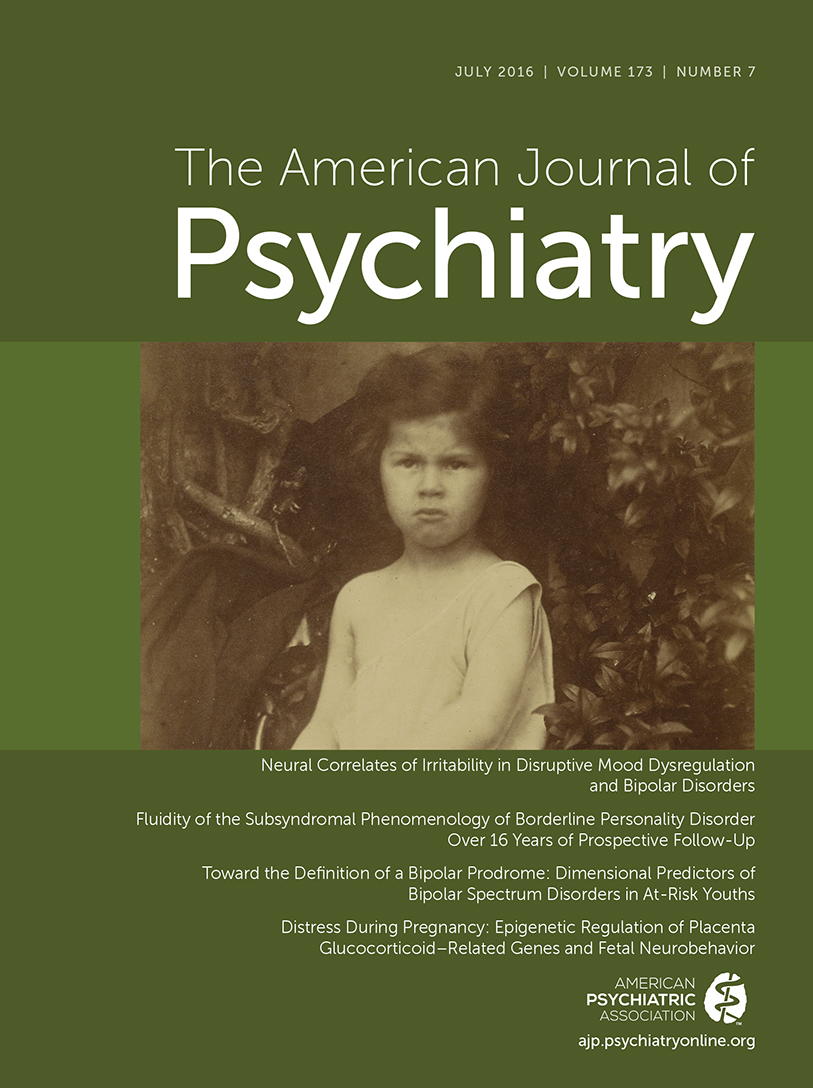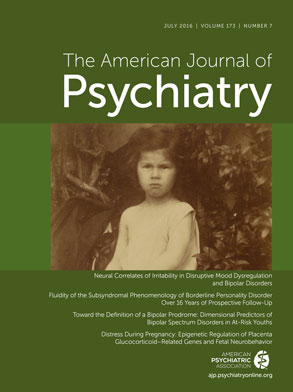It is not surprising that we live in a time in medicine where findings from biological and genetic research grab headlines (
1). Our hunger to understand on a more granular basis disease entities with which we struggle daily intensifies as new technologies become more readily and cost-efficiently available.
Yet we must not lose sight of understandings gained from more traditional observational aspects of clinical presentations of patients, as found in the study by Mary C. Zanarini, Ed.D., et al. (
2) in this issue of the
Journal. Many clinically relevant findings developed from the MSAD [McLean Study of Adult Development] study over the last 16 years, wherein 87.5% (N=231) of the original borderline personality disorder cohort are still followed every 2 years, after 16 years. Some of the more interesting findings uncovered in the first half-dozen years of the MSAD persist. Symptoms of borderline personality disorder may be divided into acute and temperamental symptoms (that the authors compare with the positive and negative symptoms of schizophrenia), with acute symptoms much more amenable to improvement and remission than the temperamental symptoms (
3). Zanarini et al. point out that the acute symptoms are not exclusive to borderline personality disorder, while temperamental symptoms are more chronic, embedded in the heart of the definition of borderline personality disorder and are probably what makes patients with the disorder so frustrating at times to work with. What appears to generate great consternation and anxiety at times among therapists is when the patient presents with acute symptoms (such as suicidal ideation or self-harm), symptoms that do improve and are the focus of many of the current specialized borderline personality disorder effective treatments (
4,
5). Attention to treatment of acute symptoms reduces the need and pressure to hospitalize or overmedicate (
4). But frustration arises when we try, with the best of intentions and probably misplaced enthusiasm, to modify the more stubborn and treatment-resistant symptoms, symptoms about which patients complain continually but that are not necessarily symptoms that put the patient in danger (
6). By trying too enthusiastically, we may iatrogenically create riskier conditions when we prescribe multiple pharmacologic combinations where there is little hard evidence for effectiveness (
7). We can get trapped in focusing on what is less likely to change, creating false hope and increasing frustration and a sense of failure. We should first focus actively on the acute symptoms, and while not ignoring the temperamental symptoms, we should modestly and humbly enter into discussions with our patients on employing the best-known strategies for dealing with the more chronic recalcitrant symptoms through strategies such as radical acceptance, distraction, mentalization, and “doing the best that one can” (
4,
5).
MSAD is a naturalistic follow-along study. It is not a treatment study and does not employ any specific treatment approach. The patients, after their initial hospitalization, were followed naturally; patients chose or did not choose specific treatments, but most were involved in some sort of psychotherapy and psychopharmacology over the course of their treatment (
8). At the study’s outset, none of what is designated currently as effective treatments were available, or if they were, they were available in very limited ways, a problem that persists to this day. Most of these patients were receiving whatever treatment they could muster in their community. Over time, and quite a brief time, the acute symptoms improved, and the majority of subjects no longer met criteria for borderline personality disorder.
This has led to two important questions. If these patients who were not in any specific effectiveness-tested therapy did show improvement, then how can we continue that practice? But further, and perhaps more importantly, how can we continue that practice and avoid interventions that cause increased difficulty and symptomatology (
9)? These questions are attempted to be answered through the development of Good Psychiatric Management, a manualized intervention approach that emphasizes not making mistakes in treatment so that the natural course (with it ebbs and flows) of the disorder can move forward. Good Psychiatric Management suggests that most borderline personality disorder patients do not require specialized interventions from expert clinicians known for their skills in working with borderline personality disorder patients, and experts in the field suggest ways to avoid iatrogenic complications. Most borderline personality disorder patients require a sensible, honest, empathic, validating, straightforward therapist who is knowledgeable enough not to make mistakes while allowing the potential of the patient and the natural positive course of the illness to unfold (
9,
10).
Careful observation of patients over time provides data that not only keeps us focused on observable clinical phenomena, but also allows us to connect with and plan for our patients’ treatments while providing guideposts to improvement. Value remains in continued observation to assess progress (or lack of some) over time while attempting to appreciate and understand more fully the different ways these patients progress.
Patients with borderline personality disorder provide a good example of the limits, as well as the benefits, of direct observation. Since the clinical presentation of these individuals seems so variable and fluid, changing from moment to moment and certainly from session to session, direct clinical observation appears somewhat limited because we cannot control for the impact of the affective or cognitive state of the patient at the moment of observation. On the other hand, many of us would contend that in experiencing the clinical presentation of a patient with borderline personality disorder on any particular day, we encounter his or her clinical presentation “unfiltered” as it were. But this unfiltered experience can lead not only to confusion as to how to judge patients’ progress at that moment, but also persuades many clinicians to avoid this experience by shying away from treating them, or giving them other diagnoses, or by deciding that they (the patients) are untreatable (
11). In order to justify distancing oneself from these troubled patients, we develop myths about them—that they are hopeless, incurable, have been put on this earth to drive us crazy, or are manipulative or sadistic.
Understanding through clinical observation the fluidity of these patients’ symptoms may provide us with a perspective that debunks many myths particularly about lack of treatability. Careful clinical observations as exemplified in the MSAD papers as a group provides data that suggest that most of these patients do much better than we have accused them of not doing. How many of us would believe that over 16 years, almost 100% of patients with borderline personality disorder experience a 2-year remission, 95% a 4-year remission, and 78% an 8-year remission? These figures emerge not from wet labs, gene sequencing, or neuroimaging, but rather from steady, careful, and repeated prospective follow-along observations of clinical signs and symptoms.
While the results from the MSAD are encouraging, many aspects of the disorder remain problematic. It is clear that much more work needs to be done with the temperamental more resistant-to-change symptoms and in understanding the increase in those symptoms under stress. But if we follow the acute symptoms and the patterns of remissions and recurrences within those acute symptoms, we are struck by how much brighter a future there is for patients who suffer with borderline personality disorder than the one the profession, the media, and the overall medical establishment has propagated in the past.

